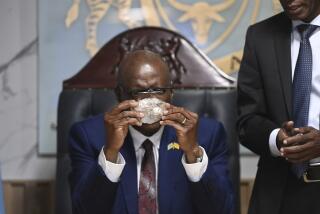Australian’s Once-in-Lifetime Gem Find : Mineral: New South Wales prospector finds mussel-shell opal worth nearly $2 million. Discovery called unique because of its size and its full spectrum of colors.
- Share via
HERVEY BAY, Australia — Bruce Parker, a weekend prospector, swung his pick one day and found a mussel-shell opal worth nearly $2 million.
The Smithsonian Institution in Washington described the 505.5-carat gem as “far superior” to the opals in its department of mineral sciences.
The Gemological Institute of America says the opal is one of the largest its experts have seen, and the Museum of Science asked to borrow it for a gem exhibition.
Parker discovered the stone, formed inside a mussel shell 100 million years old, six years ago in the Grawin opal fields of New South Wales state. It is unique because of its size and because it contains the full spectrum of colors.
Grawin, where the first Australian opal was found in 1907, is about 30 miles west of the Lightning Ridge black-opal mines.
Australia produces 90% of the world’s opals and its annual opal sales totaled nearly $75 million in the late 1980s.
Opal production has fallen because of commercial sale of synthetic opals and diamond mining in Western Australia state, but new interest from Japanese buyers has driven prices up by as much as 600% in 18 months.
Since having the “Grawin Rainbow” appraised, insured and placed in safekeeping, its owner has waited for an investor or museum to buy it.
He said the opal, about four inches long and just over two inches wide, was formed by a mixture of water and silicon that seeped into the shell.
“It could have just as easily been water and sand,” Parker said, “but the water and silicon combination formed the opal.”
Finding the gem was pure luck, he said: “There were not any other traces of opal to indicate its presence. I may have missed it had the pick not exposed its color.”
His pick cracked open the mussel shell, exposing the opal. Parker said the other piece of shell was about 1 1/2 inches long, with very little opal inside.
Officials at the Australian Museum in Sydney and at Diamond House, an Australian authentication company, assess the opal’s value at about $1.96 million. The government has told Parker that, because he is only a part-time prospector, he will not have to pay tax when he sells it.
Parker, 52, is semi-retired from his auto mechanic’s business because of an accident that cost him the vision in one eye. He has prospected part time since visiting the opal fields on vacation 25 years ago.
More to Read
Sign up for Essential California
The most important California stories and recommendations in your inbox every morning.
You may occasionally receive promotional content from the Los Angeles Times.








